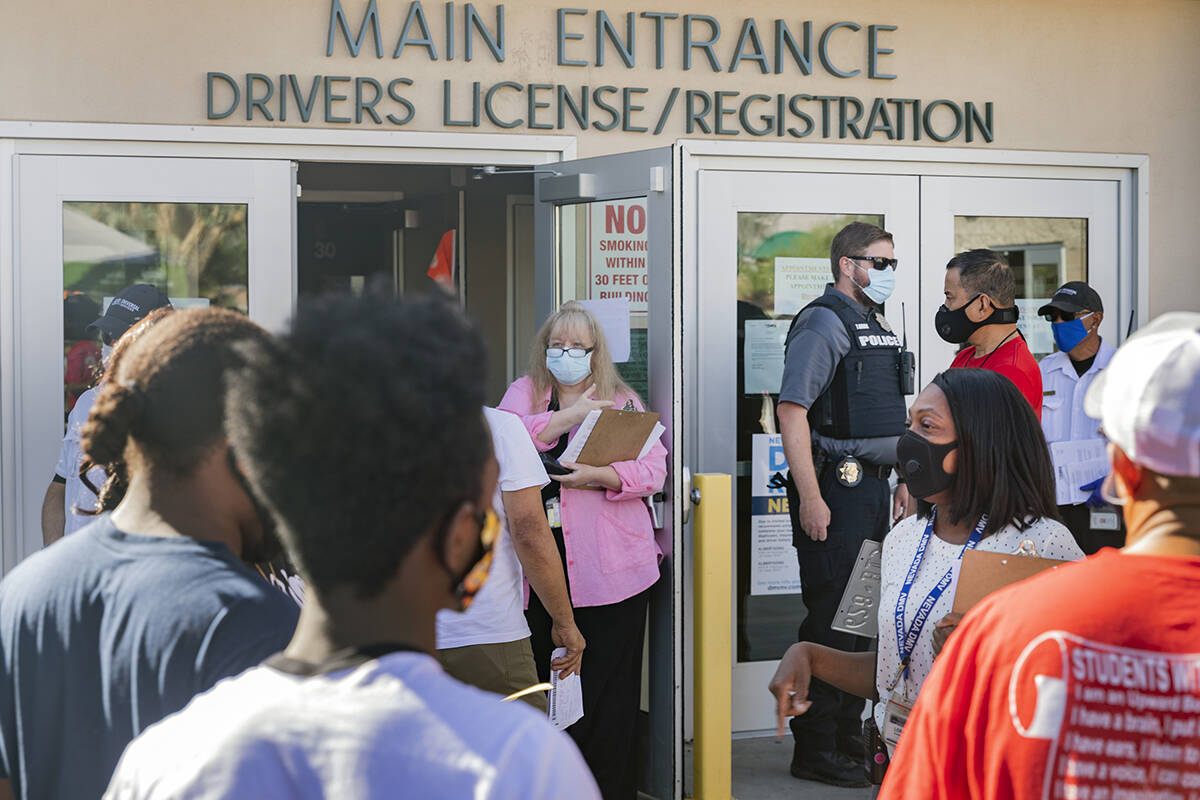Nevada DMV shifting to make most transactions available online
With the pandemic emphasizing how much Nevada residents relied on in-person Department of Motor Vehicles visits to conduct transactions, the agency is looking to the future with a major online shift.
When the COVID-19 pandemic led to a multiweek shutdown of most businesses, the DMV saw a massive backlog of transactions when operations reopened. Those who needed to carry out a transaction were finding it tough to get a spot in the appointment-only, post-shutdown operations, leading to frustration and long lines outside of DMV offices in Southern Nevada.
“In Vegas with the public wrapped around our offices and coming in the middle of the night, it really shined a light on that need to really change our business model from a brick-and-mortar services delivery to an online storefront,” DMV Director Julie Butler said.
During the initial reopening stages in the summer of 2020 and for several months thereafter, most residents couldn’t get a DMV appointment for fewer than 90 days out. The DMV has caught up on the majority of the backlog, so demand has shrunk and is sitting at around 45 to 60 days for an appointment, according to Kevin Malone, DMV spokesperson.
Although the DMV was looking at ushering in a digital age before the pandemic, the result of that created a sense of urgency to get it done quicker than originally planned, according to Butler.
“One of the things that we noticed during COVID when we were shut down is we didn’t have a mechanism for the public to do a lot of our transactions,” Butler said. “Particularly, if you bought a vehicle from a private party or you bought a vehicle from out of state, there was no mechanism to take care of their DMV business online. When we reopened, what we noticed was a huge demand for things that required you to come in.”
Opening up the online front more will allow the DMV and its customers to carry out most transactions even in the event of another pandemic, natural disaster or anything else that might shut down operations for a prolonged amount of time, Butler said.
The plan includes a gradual rollout of more services available online, with the goal of by 2026 having the ability for the majority of services the DMV provides to be carried out without setting foot in one of the agency’s offices.
“It’s going to be incremental over the next four years,” Butler said. “In the state’s past IT projects, the programmers go into a room for a period of months or years, and all of a sudden you go live with this big bang new system. That’s not what we’re doing here. We’re going to take what’s called an agile approach. Meaning it’s very much designed to be rolled out in increments.”
A gradual rollout of the system will allow the DMV not only to see some immediate results, but it also will allow the department to address any issues that may arise during the introduction of each new option. And it will let programmers add in something previously not thought of before the rollout began, Butler said.
“Not everything goes as planned the first time you roll it out with an IT project,” the DMV director said. “If it isn’t quite what we need, we won’t have to wait four years to say, ‘Hey, this isn’t what I need.’”
Once the entire rollout is complete, Butler said, almost all of the DMV transactions will be available online, but a few could still require in-person visits.
“Right now under the federal Real ID Act, if you want to get a Real ID, that transaction will have to be performed in person,” Butler said. “That’s going to take some regulatory changes on the federal side. What we hope to do with that, if they don’t make those changes, is to at least give the public the ability to upload their documents, such as their birth certificate, or proof of residency like a utility bill or a property tax bill, to prove where they live. So they can upload those documents ahead of time before their visit, so that way our technicians can let them know what they’re missing or if they provide a document that’s not right.”
When the bulk of the DMV’s services is online, it won’t mean the end of the agency having multiple offices throughout the state. Butler believes there will be a gradual shift from the bulk of customers carrying out transactions in person to online. The agency still will need to have offices open for those who aren’t comfortable using the internet to process transactions or for new residents, who are required to do in-person visits.
“Once you get established with your Nevada driver’s license or registration, there really shouldn’t be much of a need to come to an office to be established,” Butler said. “So there will be no changes in the number of staff or our ability to serve walk-ins. We’re just also going to be now providing an electronic channel for our staff to interact with the DMV.”
The DMV recently emailed a survey to Nevada residents to gauge the public’s interest in moving to a more online-based operation. Future digital surveys could follow, and focus groups are slated to be created next year to help the DMV stay current with customer service needs and preferences during the four-year process.
“We want the public’s input on what the future looks like for the DMV,” Butler said. “Customers are key to helping us enhance the DMV experience for all Nevadans.”
Contact Mick Akers at makers@reviewjournal.com or 702-387-2920. Follow @mickakers on Twitter. Send questions and comments to roadwarrior@reviewjournal.com.


















